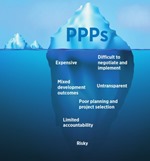What lies beneath? A critical assessment of Public Private Partnerships and their impact on sustainable development
Published on Tue, 2015-07-07 15:00
A new report launched by Eurodad examining public private partnerships (PPPs) as a way to finance development projects finds that they are risky and expensive and urges governments and financial institutions to stop hiding their true costs. The research finds that public private partnerships are expensive, risky and lack transparency. What lies beneath?: A critical assessment of public private partnerships and their impact on sustainable development examines the nature and impact of PPPs ahead of the landmark Financing for Development (FfD) conference in Addis Ababa next week (13-16 July). It analyses existing literature on PPPs and the experiences of Tanzania and Peru, based on the findings of the networks Afrodad and Latindadd. PPPs are agreements through which private financiers essentially replace governments as providers and funders of traditional public services like schools, hospitals and roads. European governments in particular, and financial institutions such as the World Bank, are planning to push the involvement of the private sector in development during the summit, despite the strong reservations of many experts in developing countries. Report author Maria Jose Romero, Policy and Advocacy Manager at the European Network on Debt and Development (Eurodad), said: “PPPs are being promoted by our leaders as the way to fund infrastructure projects and public services such as health and education, which are traditionally provided by the state. The costs of these projects are often very high, the public sector takes on most of the risks, and there is often a veil of secrecy over how these projects are negotiated.” “Our governments must take a step back during the Addis Ababa Summit and put development needs - and not the needs of private investors – first.” Governments often hide the true costs of PPPs because they can keep the project and its contingent liabilities (or future potential debt) ‘off balance sheet’. Overall, the report finds that: • PPPs are, in most cases, the most expensive method of financing, significantly increasing the cost to the public purse. • PPPs are typically very complex to negotiate and implement and all too often entail higher construction and transaction costs than public works. • PPPs are all too often a risky way of financing for public institutions. • The evidence of impact of PPPs on efficiency is very limited and weak. • PPPs face important challenges when it comes to reducing poverty and inequality, while avoiding negative impacts on the environment. • Implementing PPPs poses important capacity constraints to the public sector, and particularly in developing countries. • PPPs suffer from low transparency and limited public scrutiny, which undermines democratic accountability. Romero said: “Although there is some evidence that PPPs can improve the efficiency of certain projects, there are several examples of PPP arrangements that have gone badly wrong, and that leave a lasting legacy. “This report shows that promoting PPPs in a non-critical way is a mistake. Governments and financial institutions should focus on developing the right tools at country level to identify whether – and under what circumstances – it is desirable to use PPPs.” As the cases of Peru and Tanzania show, the experience at the country level is mixed. PPPs suffer from low transparency and limited public scrutiny, which undermines democratic accountability. In some cases, PPP projects have resulted in public discontent due to higher costs and corruption allegations. (see examples of problems that occurred in PPP projects in Notes to Editors). The report recommends that governments stop hiding the true cost of PPPs and that decision-making about PPPs is more transparent and accountable. It also recommends that development outcomes are at the forefront of any project and that developing countries are in the driving seat when principles and criteria to assess and implement PPPs are developed. The main report, and a summary briefing, can be found here: www.eurodad.org/whatliesbeneath Source: Eurodad. Tags: |
SUSCRIBE TO OUR NEWSLETTER



